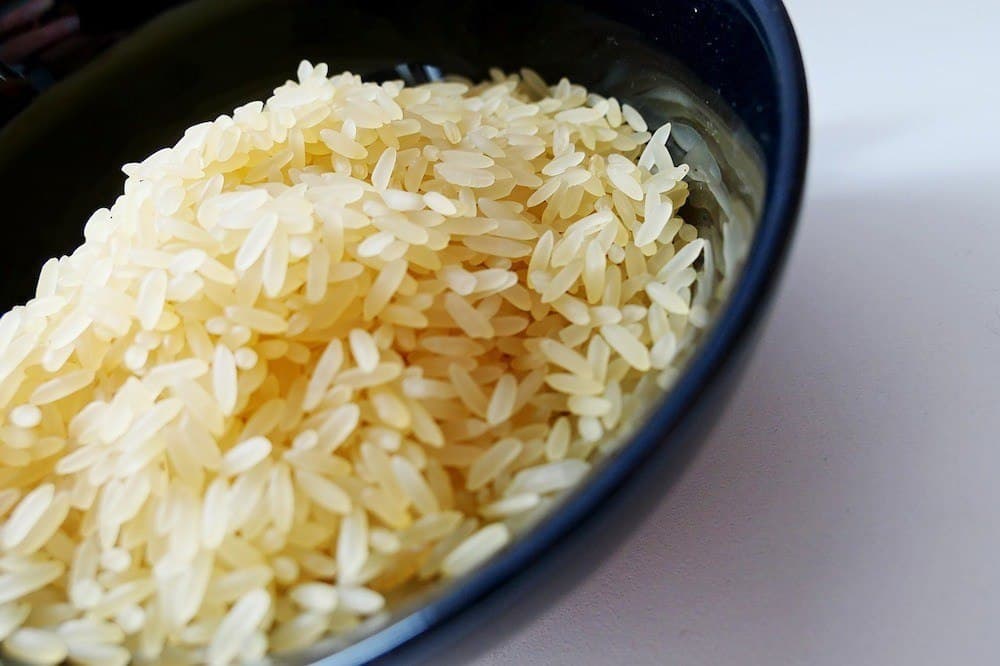No, we’re afraid not. Rice is a grain, and grains of any kind are not allowed on the Whole30 Program.
Although both brown and white rice are widely accepted as “healthy” foods, there are several reasons why they’re decidedly a Whole30 no-go.
Grains are often not well tolerated and cause digestive distress to many. They contain proteins that are very difficult for our bodies to digest, making it difficult for us to extract the nutritional value and causing inflammation along the way.
Phytates are also commonly present in concentrated amounts in many grains. These sneaky little guys are anti-nutrients that bind to vitamins and minerals in our foods like zinc, calcium, and magnesium, just to name a few, and make it so our bodies cannot even access them!
When refined (which the majority of popular grains are), grains are stripped of most of their nutritional value and can cause blood sugar spikes and insulin issues. For these reasons, grains are excluded from the Whole30 program.
Brown vs White Rice: Is One Healthier Than The Other?
Most of the digestively problematic parts of grains exist in their husk or bran—this is the “whole” part of whole grains. If we’re talking rice, brown rice has the bran and the germ left intact and is a considered a whole grain, whereas white rice is refined by removing these parts.
Many argue that this makes white rice less healthy than brown since the portion with the most nutritional value is taken away. Others may argue that since the phytates (remember those anti-nutrients that stick to your vitamins and minerals?) and difficult-to-digest proteins are present in the bran, white rice is actually healthier. No bran, no problem, right? Well, unfortunately, it’s not quite that simple.
There’s just no right way to consume rice – you really can’t win this one.
According to the Whole30 Program Rules, neither white nor brown rice is allowed. Brown rice has the husk and the germ intact along with all those practically indigestible proteins and phytates. White rice is refined by having these parts removed.
While it seems like removing the portion of the grain that causes the most issue should improve things, without the outer layers, rice just becomes a concentrated, starchy carbohydrate.
The parts of white rice that were removed to make it refined were the parts that tell your body you that you’ve had enough food and that it’s time to stop eating. There’s only about 1 gram of fiber per 100g of white rice and it does not even make up a complete protein, making it dangerously easy to over-consume.
White rice isn’t necessarily going to do the same harm as other grains might by keeping you from absorbing important nutrients, but it will just take up space you might as well use for more nutrient-dense foods. Why eat something that has little nutritional value when you can get way more bang for your buck with a different food?
Whole30 Rice Substitutes: Try These Instead!
The main allure of rice is that it’s a great pairing food—it goes well with pretty much any main course and it’s just so popular, it can be really hard to move away from! Don’t worry. There are ways around this!
Thanks to the experimentation and creativity of some awesome Whole30-ers and members of the paleo community we have some amazing rice substitutions.
Option 1: Sweet Potatoes
If you’re just looking for a nutrient-dense carbohydrate to keep you energized, look to sweet potatoes, yucca, plantains, or even white potatoes (yes, white potatoes are allowed) as a side dish.
We’ve got plenty of Whole30 sweet potato recipes to get you started if you need inspiration!
Option 2: Cauliflower Rice
If you want something more rice-like, cauliflower rice is here to save the day! You can make your own with a food processor or grater, or if you’re mess-averse and prefer the convenience of a pre-riced version, you can find one at Trader Joe’s, Whole Foods, or even Costco.
Option 3: Parnsip, Carrot, and Malanga Rice!
Feeling a little cauliflowered out? Lucky for us, recipe developers are making rice out of pretty much everything these days.
For a twist on a Whole30-compliant “rice” that isn’t made out of cauliflower, try parsnip rice, carrot rice, sweet potato rice, or malanga (a tropical starch similar to yucca!) rice. Apparently, you can rice-irize quite a few veggies!
While, to be perfectly honest, the flavors in these substitutes are definitely different from the ‘real deal’, they’ve certainly got rice beat in the nutrition department. Yummy, food good nutrition…it’s a win-win.
What are your thoughts on rice? Do you love it or can you easily live without? What’s your favorite rice substitute? Share your thoughts in the comments!





So over nearly two billion people are wrong…?
Can you explain what you mean a bit more? This is about whether or not rice is allowed on Whole30. Just because 2 billion people commonly eat rice (assuming that’s what you meant) doesn’t mean it’s necessarily good or healthy.
Sally don’t be silly.
White potatoes were not Whole 30 compliant for quite some time; then the program was changed to accept them. The reason for excluding them was never because they had phytate and/or lectins that are bad for you – it was ‘on principle’ that they are not ‘healthy.’ A case can be made that white potatoes cause some people distress, and that they can sometimes contain solanine, a potent inflammatory agent that can also be toxic. Even so, for the vast majority they present no problem, and with careful selection, you can buy potatoes that contain little or no solanine (the green ones should be avoided). So, the white potato is deemed acceptable now. The argument could be said for white rice. It is one of the world’s least problematic foods, does not contain harmful lectins or phytate. Yes, like the white (and sweet) potato, it is a concentrated source of carbs – and if carbs bother you, don’t eat them. I wouldn’t be surprised if it someday gets re-categorized as a ‘seed’ (rice is a grass) and become wholes 30 compliant as long as it does not have the bran. Even so, 30 days is not that long to go without, at least as an experiment. And like was noted already, after the 30 days, you can experiment with what you want.
It seems pretty irresponsible to encourage folks with inflammation issues to avoid rice completely in exchange for cauliflower and sweet potato both high in mannitol (esp. cauliflower which should not be consumed at all during the elimination phase of any IBS sufferers) sweet potato should not be eaten in portions excess of 1/2 cup. Wild rice strains in particular show acceptable levels when consumed in 1/4 cup portions…where are you coming up with these rules?
Just because a food is healthy does not mean it is not responsible for negative impacts on the body. That’s why the reintroduction phase of any elimination diet is considered so important to licensed dietitians and nutritionists.
Mia, I didn’t make these rules up. They come from the Whole30 diet created by Melissa Hartwig. You’ll have to read her book to understand more the science and “why” behind the eating program.
The Whole30 program actually includes a very detailed reintroduction phase, which helps determine which foods or food types may have been a source of inflammation. The Whole30 designers have identified grains as a food category that is a common source for dietary inflammation. Thus, they included it as one of the food types to eliminate in their 30 day program. They do not eliminate cauliflower or sweet potatoes because those fall under the “vegetable” food type, and vegetables are not eliminated in the 30 day program. If people have inflammation issues resulting from sweet potatoes or cauliflower, then those inflammation issues would persist throughout the 30 program and would subsequently warrant a more tailored approach with a professional nutritionist or dietician.
That said, in terms of producing dietary guidelines for the public at large — encouraging people to swap grains for vegetables is quite appropriate, as vegetables are more nutrient dense and easier for the body to digest. You’re making it sound like the Whole30 is trying to target people with inflammation triggered by mannitol and encourage them to ingest more mannitol. That’s a mischaracterization of both the intention and practical application of the Whole30. Eat your vegetables.
Just be real. Restricting more food groups results in restricting calories, and people must lose or maintain low body weight to sell a program. This is just another diet under the veil of wellness. Yes, cooking more and eating fewer processed foods is healthy. But cutting out brown rice, soy, yogurt, etc is not justified by the macro lens of nutrition research and is just a way to force you to eat less.
I’ve completed my whole30 days and feel such a significant improvement with inflammation to my hands , feet and entire body. I didn’t feel like I deprived myself, I felt like I needed to say no to foods that were on the list, which turned out to be better for my body. More energy, less to no cravings, no swelling, the list goes on…
That’s such great news Elizabeth!